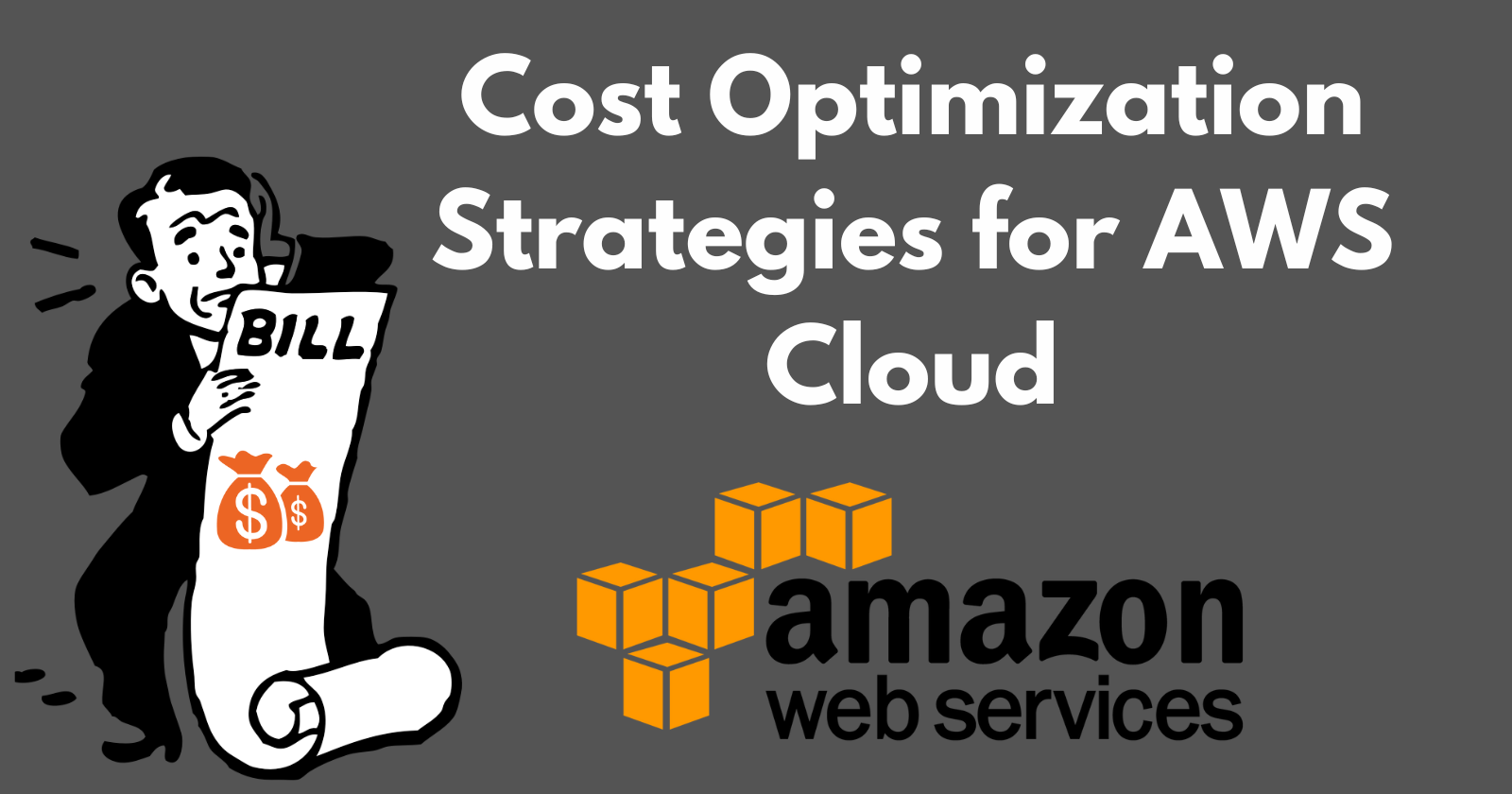Cost Optimization Strategies for AWS Cloud: Save Smart, Spend Smart
 Nikunj Vaishnav
Nikunj VaishnavTable of contents
- 1. Right-Sizing Your Instances
- 2. Leverage Reserved Instances and Savings Plans
- 3. Use Spot Instances for Non-Critical Workloads
- 4. Implement Auto-Scaling
- 5. Optimize Storage Costs
- 6. Take Advantage of Cost Management Tools
- 7. Optimize Data Transfer Costs
- 8. Monitor and Manage Idle Resources
- 9. Use Serverless Architectures
- 10. Educate Your Team
- Conclusion

In today's digital world, cloud computing is more than a buzzword-it's a necessity. Amazon Web Services (AWS) stands as a titan in this realm, offering a vast array of services to cater to every business need. However, with great power comes great responsibility, and managing AWS costs can be a daunting task. Fear not! Here are some effective cost optimization strategies to help you navigate your AWS expenses wisely.

1. Right-Sizing Your Instances
One of the easiest ways to cut costs is by ensuring that your instances are appropriately sized for their workload.
How to Implement:
Analyze: Use AWS CloudWatch and Trusted Advisor to monitor CPU, memory, and network usage.
Adjust: Downsize or upscale your instances based on the data.
Automate: Implement auto-scaling groups to dynamically adjust instance size according to demand.
2. Leverage Reserved Instances and Savings Plans
AWS offers significant discounts (up to 75%) for committing to use certain instances over a period (1 or 3 years).
How to Implement:
Evaluate Usage: Identify stable, predictable workloads.
Purchase: Buy Reserved Instances or Savings Plans for these workloads.
Monitor: Regularly review your reserved capacity to ensure it matches your actual usage.
3. Use Spot Instances for Non-Critical Workloads
Spot Instances can provide up to 90% savings compared to On-Demand pricing.
How to Implement:
Identify Workloads: Use for non-critical, flexible workloads like batch processing, data analysis, and CI/CD pipelines.
Set Up: Use EC2 Spot Fleet or Spot Instance requests to bid on spare capacity.
Balance: Combine On-Demand, Reserved, and Spot Instances for cost efficiency and reliability.
4. Implement Auto-Scaling
Auto-scaling automatically adjusts the number of EC2 instances based on your needs.
How to Implement:
Define Policies: Set up scaling policies based on metrics like CPU usage, memory, and custom CloudWatch metrics.
Set Limits: Ensure minimum and maximum instance limits are set to avoid over-provisioning.
Review: Regularly evaluate performance and adjust policies as needed.
5. Optimize Storage Costs
AWS offers various storage classes, each with different cost structures and access patterns.
How to Implement:
Categorize Data: Identify frequently accessed (hot) data and infrequently accessed (cold) data.
Use Tiered Storage: Move infrequently accessed data to cheaper storage options like S3 Standard-IA, S3 Glacier, or S3 Glacier Deep Archive.
Enable Lifecycle Policies: Automate data transfer between storage classes based on access patterns.
6. Take Advantage of Cost Management Tools
AWS provides several tools to help you monitor and optimize costs.
How to Implement:
AWS Cost Explorer: Analyze spending patterns and identify cost-saving opportunities.
AWS Budgets: Set custom cost and usage budgets to receive alerts when you exceed thresholds.
AWS Trusted Advisor: Use recommendations to optimize resources and reduce costs.
7. Optimize Data Transfer Costs
Data transfer costs can quickly add up, especially with cross-region data movement.
How to Implement:
Keep Data Local: Whenever possible, keep data transfer within the same region.
Use CloudFront: Implement Amazon CloudFront to reduce data transfer costs and improve performance.
Review Transfer Patterns: Regularly analyze your data transfer patterns to identify potential optimizations.
8. Monitor and Manage Idle Resources
Unattended or idle resources can contribute to unnecessary costs.
How to Implement:
Regular Audits: Conduct regular audits to identify and terminate idle EC2 instances, unused EBS volumes, and orphaned snapshots.
Automation: Use AWS Lambda scripts to automate the shutdown of idle resources.
9. Use Serverless Architectures
Serverless services like AWS Lambda and AWS Fargate can reduce costs by eliminating the need to manage underlying infrastructure.
How to Implement:
Evaluate Workloads: Identify suitable workloads for serverless computing.
Migrate: Move appropriate workloads to AWS Lambda or AWS Fargate.
Monitor: Track usage and costs to ensure optimal performance and savings.
10. Educate Your Team
Ensure your team is well-versed in AWS cost optimization techniques.
How to Implement:
Training: Invest in regular AWS training and certification for your team.
Best Practices: Develop and document cost optimization best practices.
Culture: Foster a culture of cost awareness and accountability.
By implementing these strategies, you can take control of your AWS costs and ensure that you're getting the most value for your investment. Remember, cost optimization is an ongoing process, so regularly review and adjust your strategies to align with your evolving needs. Save smart, spend smart, and let AWS power your growth efficiently.
Conclusion
By implementing these cost optimization strategies, you can take control of your AWS expenses and ensure that you're maximizing the value of your investment. Remember, cost optimization is an ongoing process, so regularly review and adjust your strategies to align with your evolving needs. Save smart, spend smart, and let AWS power your growth efficiently.
Thanks for reading. !!
Connect and Follow:
Like👍 | Share📲 | Comment💭
Subscribe to my newsletter
Read articles from Nikunj Vaishnav directly inside your inbox. Subscribe to the newsletter, and don't miss out.
Written by

Nikunj Vaishnav
Nikunj Vaishnav
👋 Hi there! I'm Nikunj Vaishnav, a passionate QA engineer Cloud, and DevOps. I thrive on exploring new technologies and sharing my journey through code. From designing cloud infrastructures to ensuring software quality, I'm deeply involved in CI/CD pipelines, automated testing, and containerization with Docker. I'm always eager to grow in the ever-evolving fields of Software Testing, Cloud and DevOps. My goal is to simplify complex concepts, offer practical tips on automation and testing, and inspire others in the tech community. Let's connect, learn, and build high-quality software together! 📝 Check out my blog for tutorials and insights on cloud infrastructure, QA best practices, and DevOps. Feel free to reach out – I’m always open to discussions, collaborations, and feedback!